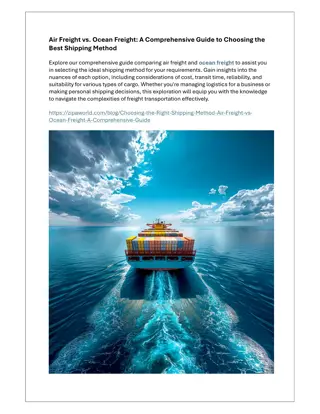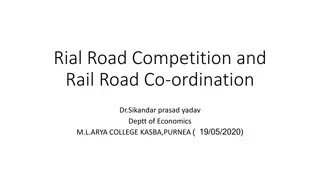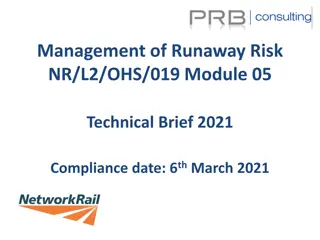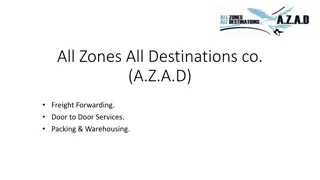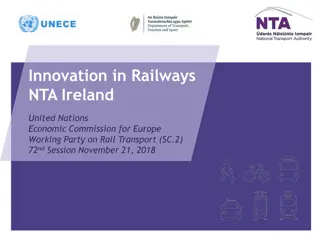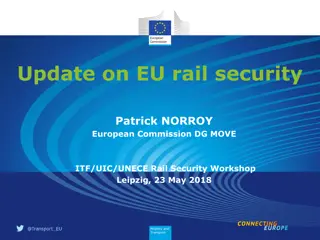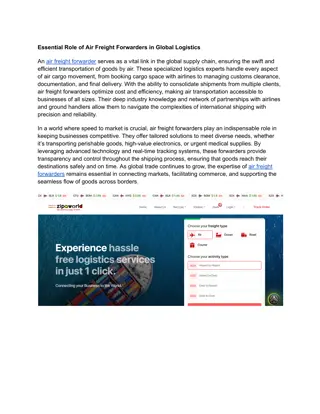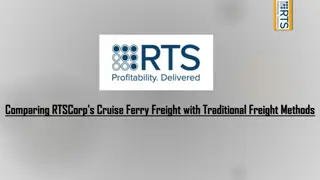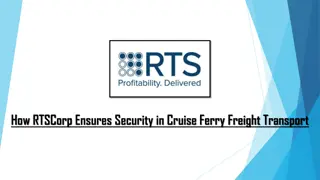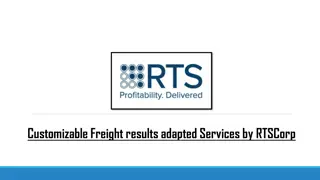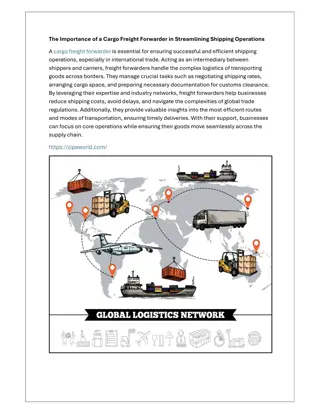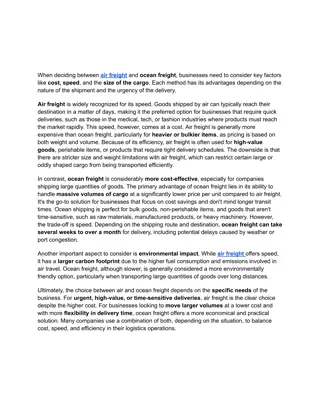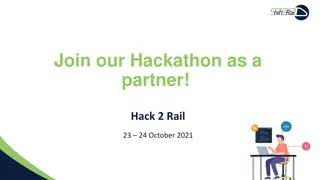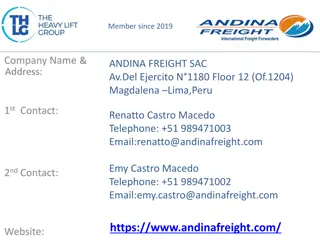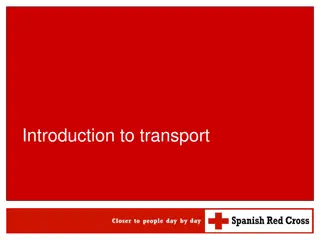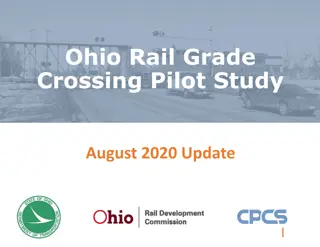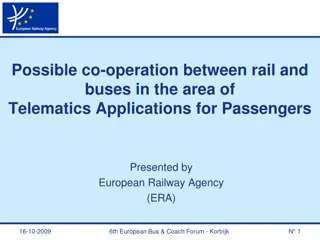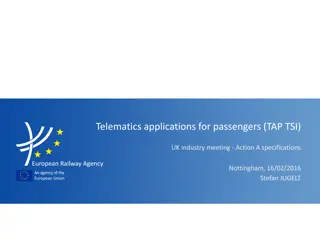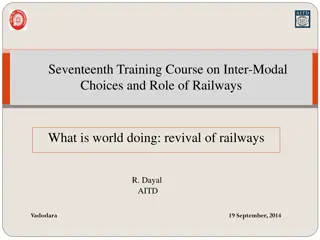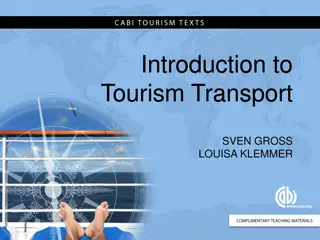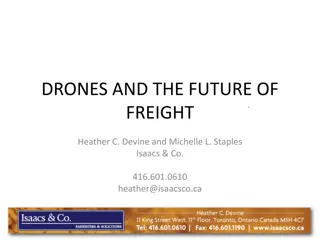Future Investments in European Rail Freight Transport
European Rail Freight Association (ERFA) focuses on future developments and investments in European rail freight transport to improve competitiveness by reducing costs, enhancing quality and performance, and addressing access barriers. Key challenges include track access charges and the need for transparency to ensure rail's competitiveness against road transport. ERFA aims to enforce EU rules and promote modal shift towards rail services.
Download Presentation

Please find below an Image/Link to download the presentation.
The content on the website is provided AS IS for your information and personal use only. It may not be sold, licensed, or shared on other websites without obtaining consent from the author. Download presentation by click this link. If you encounter any issues during the download, it is possible that the publisher has removed the file from their server.
E N D
Presentation Transcript
Future developments and investments in European Rail Freight Transport and Logistics Conference Carole Coune Acting S.G. Brussels, 22th March 2018 www.erfarail.eu
Who we are ? 30 members
WHO DO WE REPRESENT? Our role ? Freight railway undertakings (34 % market share) Wagon keepers, Freight forwarders, National associations Support for a truly competitive rail sector. The rail incumbents have an interest to protect their market share and a kind of status quo. Our members are united in a shared interest to expand their businesses and generate more demand for rail services Modal shift Reducing rail s costs Improving quality and performance Removing access barriers and competitive distortions
The main future developments/investments in rail freight will take place in the field of these 3 challenges Reducing rail s costs Improving quality and performance Removing competitive distortions COMPETITIVENESS
The main future developments/investments Reducing rail costs Track access charges Internal challenge - Rail freight operators needs : transparent rules and according to the EU framework, in all the member states
WHY ? Enforcement and transparency TAC Road does not pay a similar per km toll Rail TACs = 20- 35% of RU costs increase WITHOUT improvt of quality competitiveness The level of rail s track access charges is critical to rail s competitiveness and can be a real barrier to modal shift! EU rules exist to improve TRANSPARENCY, CONSISTENCY and EFFICIENCY of Access Charges BUT Enforcement Transparency of what RUs are paying for ERFA aims to Improve visibility and enforcement of EU rules by IM and Member States
The main future developments/investments Reducing rail costs Track access charges External challenge - Rail freight operators needs : track access charges competitive with road
WHY ? USER PAYS PRINCIPLE NOT CONSISTENT TAC Road does not pay a similar per km toll TACs = 20- 35% of RU costs increase WITHOUT inprovt of quality Rail competitiveness User pays principle Trains pay for every single kilometer of track, in line with the distance-based principle. Trucks charges are limited and fragmented: depending on Member States Can the revision of the EU road charging legislation help? Is there political support to restore a balance ? 20% of motorways and main roads in Europe are tolled. 100% of the European rail network is tolled. Covers 20% of road infrastructure costs Covers 60% infrastructure costs
The main future developments/investments Improving quality and performance Interoperability ERTMS / Noise reduction/Languages Dig. O.D.
The main future developments/investments ERTMS Single harmonised Control, Command, Signalling and Communication system that is fully interoperable across borders. 2 parts : The European Train Control System (ETCS), and the Global System for Mobile communications Railways (GSM-R) 2 kind of investments : on infrastructure / on board A necessity for a safe, efficient and competitive single european rail market
Aim for the ERTMS goals! Europe wide interoperability One single truly interoperable system Full compatibility Backwards and forwards Track and train Whoever the supplier Reducing the costs Removing the borders Improve competitiveness with road Increasing modal shift to rail Improved safety Reducing system costs Accelerate change Increased railway capacity
The main future developments/investments Improving quality and performance Interoperability ERTMS why is ERFA, the voice of new entrants, supporting ERTMS ?
The main future developments/investments Improving quality and performance Interoperability ERTMS why is ERFA, the voice of new entrants, supporting ERTMS ? ERFA members are operating crossborder freight trains with high quality and efficiency aims, using their access rights on the single european rail area. Trains equipped with ERTMS systems and components manufactured by any qualified ERTMS supplier are able to run on tracks equipped with ERTMS of any other supplier. This enables the easy and seamless coordination of domestic and international train services and it also encourages competition
The main future developments/investments Improving quality and performance Interoperability ERTMS why is ERFA, the voice of new entrants, supporting ERTMS, financed by IM/MS and RU supported by EU funds ? Confident that the condition to succeed will be met before 2030: the benefits for infrastructure, maintenance, capacity and performance RU s costs for deploying ERTMS
The main future developments/investments Improving quality and performance Interoperability ERTMS / Noise reduction/Languages Dig. O.D.
The main future developments/investments Noise reduction UIP wagon keepers (50 % tons-km in Europe)+ ERFA members + others about 0, 5 billion wagons to retrofit in Europe ? Target : 2026 ? 2028 ? With exemptions ? Our position : First international wagons, then national approach (where the definition of international is based on the use of the wagon)
The main future developments/investments Improving quality and performance Interoperability ERTMS / Noise reduction/ Digitalisation Open data Languages
DIGITALISATION : ETRMS is the backbone of digitalisation Digitalisation Asset Intelligence => which improvements ? Optimized maintenance Customer benefit Improved productivity Higher reliability Better understanding of damages Early recognition of damages Reduction of damages New services for customers Improved estimated time of arrival Real time tracing of transports Event messages tailored for the customer s needs Real time fleet management Real time shock detection Monitoring of the good s quality in real time Reduced turnover time Improved processes at workshops Reduced manual wk Specific thresholds, e.g. Temperature Better forecast of fleet utilization Pro-active handling Triggered actions
OPEN DATA : common understanding => A single european language ? DRIVER LANGUAGE Language requirements are costly for the rail business They remove the economic incentives for transporting goods on rail over longer distances ERFA Promotes ONE SINGLE OPERATIONAL LANGUAGE for rail One Single operational language will allow rail to compete with other modes of transport!
The main future developments/investments Removing competitive distortions COMPETITION AND COOPERATION
COMPETITION ISSUES ERFA strongly welcomes the decision by the European Commission (end 2017) to fine the Lithuanian incumbent rail company 28 million Euros for an unprecedented case of anti-competitive behavior that took place in 2008: dismantling public rail infrastructure in order to penalise a rail customer! The competition rules has to be enforced everywhere in Europe. COOPERATION ISSUES Open dialogue between ALL RUs , IMs and EU decision-makers => handbook for contingency management First step to effective cooperation between IM/RU



